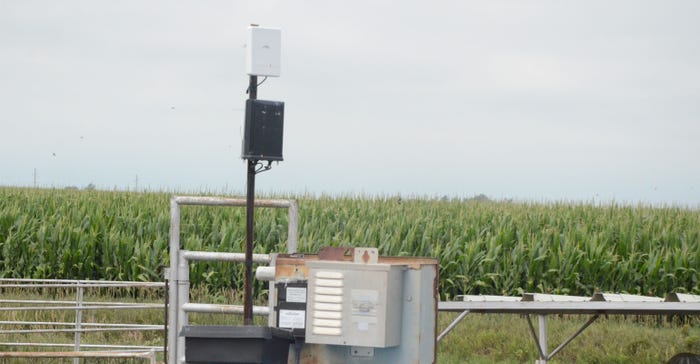Allflex offers SenseTime for beef, letting producers track cattle health through wearable ear tag technology.

What could you do if you knew in real-time which cows were in heat? What about cows that are anestrus? Or, maybe they’re just not feeling well?
Last year, Allflex and its subsidiary, SCR, launched SenseTime remote monitoring technology for dairy farms in the U.S. And this summer, Allflex Livestock Intelligence launched the SenseTime monitoring system for beef operations with the goal of helping beef producers monitor cow health, including catching health issues early and identifying which cows are in heat.
The technology uses an eSense electronic ear tag, which not unlike a Fitbit, monitors movement in cattle to determine when an animal deviates from an established norm, indicating estrus, illness or stress induced by feed or other environmental events. The tag sends a signal to the SenseTime controller installed in the pasture or feedlot. From there, the controller transfers data to the office on the farm or ranch via Wi-Fi.
“The ear tag is measuring different motions. Through research we understand what that different motion is. We can convert it and say, ‘This animal is in heat. This animal is in distress.’ We call them ‘cow states,’ and we look at all the different things happening with the animal, interpret it, and say which [category] does this animal belong in?” explains Brandt Kreuscher, dairy business manager at Allflex. “We know animals love to do the same thing every day. We can see the motion an animal makes when she pants, or the motion she makes when she’s ruminating, and we know when they’re different.”
Developing a baseline
Once the ear tag is placed on the cow and the controller device is installed, the tag develops a baseline for that cow using an algorithm. The tag tracks movement patterns for that specific animal that it correlates to various cow states, including rumination, medium activity (leisurely walking), eating and resting. When cows deviate from the baseline, it’s a sign something is going on.
For example, one of the cornerstones of this monitoring system, Kreuscher notes, is rumination. The amount of time a cow spends ruminating is a good indication of how healthy and comfortable she is, or whether she’s in distress or estrus.

COVERAGE AREA: A SenseTime reader is mounted in a pasture where tagged heifers graze. These boxes can cover an area about 1,500 by 800 feet. The amount of area covered ultimately depends on terrain, and the direction the boxes are facing.

“Rumination is clearly a voluntary behavior. Animals do it when they’re comfortable, and animals do it when they’re content,” he says. “They don’t do it often in the auction yard. But they also don’t do it often when they’re in estrus because they’re focused on other things.”
Through a handheld smartphone app or a web-based portal, users can keep track of which animals are in these cow states, and stay updated through reports on which animals are in heat and which animals are experiencing health issues. A heat index and health index from zero to 100 are used to help make the system easy to use.
The health report, or “Animals to Check” list, gives a list of animals with a health index of 85 or lower. These cows may not be feeling the best, but it likely isn’t a clinical problem at that point. However, animals at 75 and below will likely need to be checked right away.
“The way that’s going to be derived from the information is it’s going to look at a certain percentage of change difference in what their daily rumination and activity levels are,” says Tracy Jennings, animal research specialist at Allflex Livestock Intelligence.
Heat report
The “Cows in Heat” report gives a list of cows with a heat index of 50 or above, and gives the ear tag number, group number and breeding window for each cow on the list.
“A cow that’s having a normal day is going to have long bouts of eating, long bouts of lying time, long bouts of rumination. A cow that’s in heat is going to do all those things, but it’s going to be a lot more sporadic. Instead of two or three hours of rumination at once, she’s going to be more split up,” says Steve Pavelski, software training and field support manager at Allflex Livestock Intelligence. “We measure change. If we look at that cow’s baseline and she’s doing something different today, she’s going to be on the health report or the heat report.”
“Ultimately, the goal is to let your animals tell you how things are going, and when they need attention,” Kreuscher says. “We don’t replace the need for good cow people, and God isn’t making more of them. But what we can do is tell good cow people to target their time to the animals they need to pay attention to.”

COW STATES: Brandt Kreuscher says “cow states,” or daily activities, are monitored through certain movement patterns associated with different cow behavior. Movement patterns by individual cattle are interpreted and correlated to various states, including rumination, resting, heavy breathing and eating.

The system is priced by tiers, with the highest tier (which covers estrus and health monitoring) costing $72 per ear tag, along with a $2,750 cost to set up the controller. The ear tag battery lasts three years.
About the Author(s)
You May Also Like



.png?width=300&auto=webp&quality=80&disable=upscale)
.png?width=300&auto=webp&quality=80&disable=upscale)
